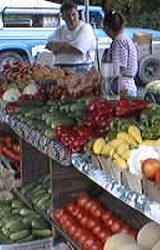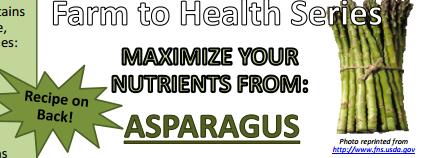Fresh vegetables and fruits available at farmers markets, or from a local orchard, can be an important part of our healthy diet. These foods provide fiber, vitamins and minerals to prevent chronic disease, help keep our weight down, and to maintain our bodies at an optimum level. On occasion, these fresh foods can be contaminated with harmful bacteria or viruses, such as E. coli or Salmonella (example – E. coli and spinach). While the high profile cases have involved large produce operations and on occasion – produce grown in other countries – it is always good to follow safe food handling techniques to protect your family and your investment.
Tips for shopping for, storing, and eating fresh vegetables and fruits (of course we want that to be at the farmers market or an orchard – if at all possible):
- Plan your trip before going, by bringing clean canvas or “go green” bags, and a cooler or insulated bag.
- Arrive at the farmers market early. The market in my community opens at 8:00 AM on Saturday; I usually try to arrive around 8:30 AM in order to get the best selection. Fresh produce is perishable once cut, so keeping it between 34 and 40 degrees is best. As the days heat up, your foods will lose quality. Use your cooler.
- Look for produce that is not bruised or damaged as you shop. If they offer you a discount for something that appears slightly damaged, remember to cut off those areas before you refrigerate them.
- When you get home, store fresh produce without washing to prevent mold. If you see visible dirt, wipe off with a clean, dry cloth before storing.
- Once you are ready to prepare or eat your fresh produce – start by washing your hands well with warm, soapy water for at least 20 seconds and clean your preparation surface. Next wash all whole vegetables and fruits, even if you will be removing the skins or rind. For firmer produce, use that trusty produce brush. Do not use soap or bleach on produce. Research from the University of Maine actually found that the best cleaner for fresh produce was distilled water, but cold tap water also worked well.
- Dry cleaned produce by patting with a clean cloth or paper towel.
Ohio State University Extension has prepared a wonderful new series of cards that will be distributed at Farmers Markets in Ohio this year to promote the benefits of Ohio produce and provide tips for preparing, storing, and enjoying fresh foods; to check these out go to http://localfoods.osu.edu/maximizenutrients.
distributed at Farmers Markets in Ohio this year to promote the benefits of Ohio produce and provide tips for preparing, storing, and enjoying fresh foods; to check these out go to http://localfoods.osu.edu/maximizenutrients.
For more on storing fresh vegetables and fruits and tons of ideas for recipes try http://www.fruitsandveggiesmorematters.org/.
Writer: Lisa Barlage, Extension Educator, Family and Consumer Sciences, Ohio State University Extension, Ross County, barlage.7@osu.edu.
Reviewer: Kathryn Dodrill and Candace Heer, Extension Educators, Family and Consumer Sciences, Ohio State University Extension.
Sources:
OSU Extension, “Farm to Health Series”, http://localfoods.osu.edu/maximizenutrients.
Foodsafety.gov Blog, “Tips for Fresh Produce Safety”, http://www.foodsafety.gov/keep/types/fruits/tipsfreshprodsafety.html.
Fruits and Veggies More Matters, “Storing Fresh Fruits and Vegetables for Best Flavor”, http://www.fruitsandveggiesmorematters.org/wp-content/uploads/UserFiles/File/pdf/why/Storing_Fruits_Veggies_FINAL.pdf.
Texas Cooperative Extension, “Safe Handling of Fresh Fruits and Vegetables”, http://tarrant-tx.tamu.edu/files/2013/08/Safe-Handling-of-Fresh-Fruits-and-Vegetables.pdf.
The University of Maine, “Best Ways to Wash Fruits and Vegetables”, http://umaine.edu/publications/4336e/.
